
Familiarising yourself with your chameleon’s habits and behavior means you can be quick to spot when there may be something wrong. What are the signs that a chameleon is dying and what can be do about it?
The signs that a chameleon is dying are usually decreased appetite and weight loss, decreased activity, shaking, and sunken eyes. Chameleons that have their eyes closed during the day are usually dying or very sick and need to be brought to a veterinarian immediately.
In this article, we’ll explain all you need to know about a chameleon dying such as:
- Disease symptoms in chameleons
- What to do if you think your chameleon might be dying
- How to differentiate between a dying, sleeping, and brumating chameleon
- What to do after your chameleon dies
- How to prepare a chameleon’s
tank for a new arrival.
This article might not be about the most cheerful topic, but it will help you prepare for what to do if you think your chameleon is dying.
Table of Contents
How To Tell That Your Chameleon Is Dying
As we already mentioned, getting to know your pet’s habits and routines, will make it easier to spot a potential problem.
In this section, we’ll go through some signs that a chameleon isn’t doing too well and what you can do about it.
If your chameleon isn’t very well or is close to death, you might be able to see some of the following signs.
Disclaimer: the information below should be used as a guide only. If you think your chameleon isn’t very well or is close to death, contact your reptile veterinarian immediately.
1. Color Change

Often a chameleon’s usually bright and colorful skin can turn dull or darker when they’re unwell. If you find it hard to tell if your chameleon’s skin is changing, you can take photos each day for comparison.
Dull skin color is also linked to dehydration, we’ll talk about that later.
You can read more about color changes in chameleons in our article 7 Reasons Why Your Chameleon Is Brown.
2. Decreased Activity
A chameleon who is very unwell will become lethargic or have decreased energy levels. This means that they might not react when you approach them or they may stay all day on the floor of its
Aside from illness, chameleons may also become less active if they are preparing for brumation during the colder months. We’ll talk more about brumation later.
Also read: 6 Reasons Why Your Chameleon Is Shaking
3. Dehydration
Signs of dehydration in chameleons are saggy skin, sunken eyes and loss of brightness. Dehydration is often related to infectious diseases in chameleons, which we’ll talk more about later.
Always make sure your chameleon has access to clean, fresh water preferably using a dripper system. It’s also important to mist its enclosure regularly, as chameleons also like to drink water from plants in its environment.
4. Loss Of Weight Or Appetite
If you notice that your chameleon doesn’t eat its
Pro tip: Weigh your chameleon every week to help monitor even subtle changes in weight.
5. Your Chameleon Is Sleeping During The Day
A healthy chameleon will not sleep during the day. Chameleons are diurnal, which means they are active during the day and rest at night.
If you see a chameleon sleeping (with its eyes closed) during the day, be sure to check that all the parameters in its
In general, seeing a chameleon with its eyes closed during the day is not a good sign, and probably means that something is wrong. We’ll talk more about this in the next section.
6. Your Chameleon’s Eyes Are Closed
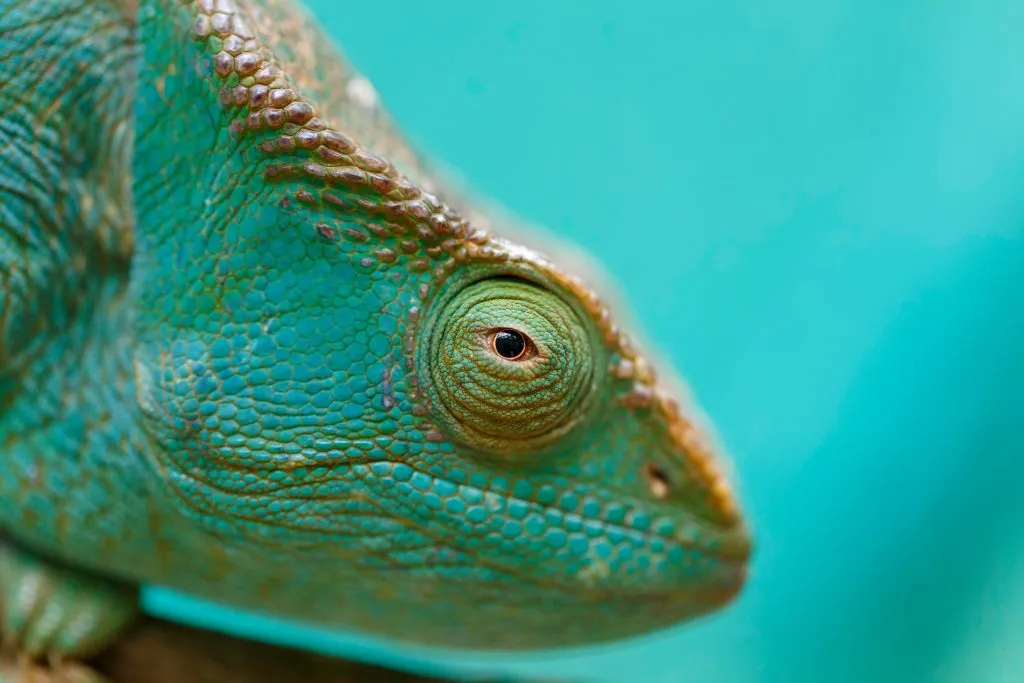
As we mentioned above, a chameleon who appears to be sleeping during the day with its eyes closed is not a good sign.
Chameleons usually always keep their eyes open. It’s okay if you see a chameleon with closed eyes at night whilst they’re sleeping, but at any other time it’s a sign of a problem.
A chameleon with closed eyes could be due to:
- Vitamin A deficiency leading to blockage of its tear duct (source)
- Too low humidity in its
tank - Bacterial infection
Don’t forget that a chameleon that cannot see will also not eat. This means they will lose weight and become even more sick.
If your chameleon has closed eyes, take them to a reptile veterinarian as soon as possible for proper diagnosis and treatment.
7. Your Chameleon Fell Off A Branch
Chameleons seem to be a bit clumsy and move in a weird manner, but they are fantastic climbers.
The strength they have in their claws and legs is incredible and they use their tails as safety line so that they don’t fall even if a branch breaks or they miss the branch.
A chameleon that falls off a branch is usually sick. More often than not, the cause for this is metabolic bone disease.
What To Do If Your Chameleon Is Dying
If you think your chameleon might be unwell, the first thing to do is check its
- Is its
tank big enough? Atank that is too small, won’t cause your chameleon to die, but it could make them stressed which could lead to illness later on. Different species require different sizes. You can read about atank set-up for a veiled chameleon in this article. - Do they have access to a basking spot with a heat lamp giving a temperature between 95 and 110 degrees Fahrenheit?
- Is the basking spot at least 12 inches below the heat lamp?
- Does the chameleon have 12 hours of light and darkness each day?
- Do they have access to UVA and UVB lighting?
- Is the humidity level appropriate? 50% humidity is minimal for chameleons, you can increase the humidity levels by misting its
tank . Measure the humidity with a hygrometer placed in the middle of thetank . The humidity can be increased whilst the chameleon is shedding. - Do they have access to water using a dripper system and is its tank regularly misted?
- Is temperature gradient appropriate?
- Is the
tank and its components clean? - Are they fed an appropriate diet with gut-loaded and vitamin A dusted insects and plants?
- Do they receive a supplement with vitamins A and D?
Once you’ve checked and corrected all the above points, depending on how weak your chameleon is, you’ll probably decide to contact a reptile veterinarian.
During the consultation with a reptile veterinarian, be sure to explain all the circumstances surrounding your pet’s change in condition.
If you can, it’s also good to bring a sample of your chameleon’s poop with you in case your vet wants to perform diagnostics on it.
How To Differentiate Between A Dead Chameleon, Brumating Chameleon, And Sleeping Chameleon?

Have you ever wondered about how to tell whether your chameleon is dead, sleeping, or brumating?
It could be difficult to differentiate, so we’ve described how to tell the difference below.
Dead Chameleon
If you think your pet chameleon may have passed away, check for the following signs:
- Stiffness – rigor mortis begins soon after death. Be aware that if rigor mortis finishes after around 3 days, so if your chameleon died a few days prior, the rigor may not be present anymore.
- Smell – similarly, if your chameleon has been dead for a while, its body might have started to decompose and give an unpleasant smell.
- Color change – if your chameleon has died, the color of its skin will become darker (probably black or brown).
The Color Of A Dead Chameleon
Dead chameleons are usually black or brown. However, shortly before a chameleon dies, its colors become bright for a last time. The video below shows what we mean.
If you find your chameleon dead in its
Brumating Chameleon
When the external temperature becomes cooler, usually during November, chameleons naturally start the process of brumation (reducing their metabolism).
In the wild, brumation helps chameleons to conserve energy when
During brumation, a chameleon won’t move, and it will stop eating, drinking, and passing feces. Brumation in reptiles is similar to hibernation in mammals.
If your chameleon is breathing but has stopped passing feces and hasn’t eaten or had a drink in a while, they’re probably brumating.
If you think that your pet chameleon is brumating, reduce the time the lights and heat sources are switched on and try to lower the temperature a bit to mimic the colder season.
Tip: Remember to put the heat lamp outside your chameleon’s
tank , to decrease the risk that they suffer from burns.
Sleeping Chameleon
Chameleons usually only sleep during night-time. If you see your chameleon sleeping during the day, it’s a sure sign that something is wrong. A healthy chameleon won’t sleep during the day.
A sleeping chameleon will close its eyes and probably won’t be too pleased if you disturb them! If you wake up a sleeping chameleon, it may change color.
Do Chameleons Die Fast?
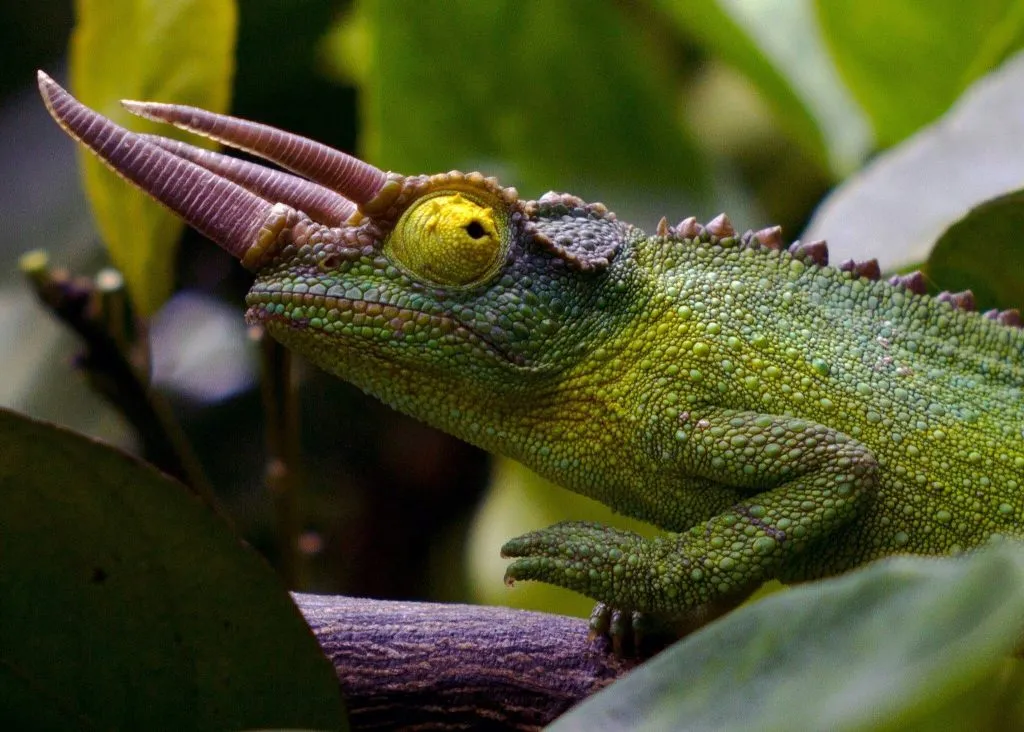
Common pet chameleon species like the veiled chameleon and the panther chameleon do not die fast as they are pretty hardy.
However, smaller, more delicate chameleon species are more prone to stress, which can weaken their immune system and can lead to death quickly.
Besides that, many chameleon species are pretty unforgiving when it comes to mistakes in the
In this section, we’ll go through some conditions in chameleons that could cause them to become unwell or die and how to avoid them.
Stress
Although stress isn’t a direct cause of death in chameleons, it could reduce their immunity and make them more susceptible to diseases.
You can help reduce stress by making sure your chameleon’s
Respiratory System Infection
Respiratory infections are often linked to inappropriate
Signs of a respiratory infection in chameleons include:
- Breathing with its mouth open (similar to a dog panting) or skyward
- Decreased appetite
- Acting more tired or slow than usually
- Material (discharge from the nose, eyes, or mouth).
Disclaimer: The above list of symptoms should be used as a guide only. Check and correct humidity and temperature parameters in your chameleon’s
tank before contacting a reptile veterinarian if you think your chameleon might have a respiratory infection.
Heat Lamp Burns
If you notice that your chameleon has gray areas on its skin or that its back spikes have changed, they might have been burned by its heat lamp.
If you think your chameleon has been burned, take them to a reptile veterinarian immediately.
Don’t forget that heat lamps should always be placed at least 12 inches away from the animal.
Dehydration
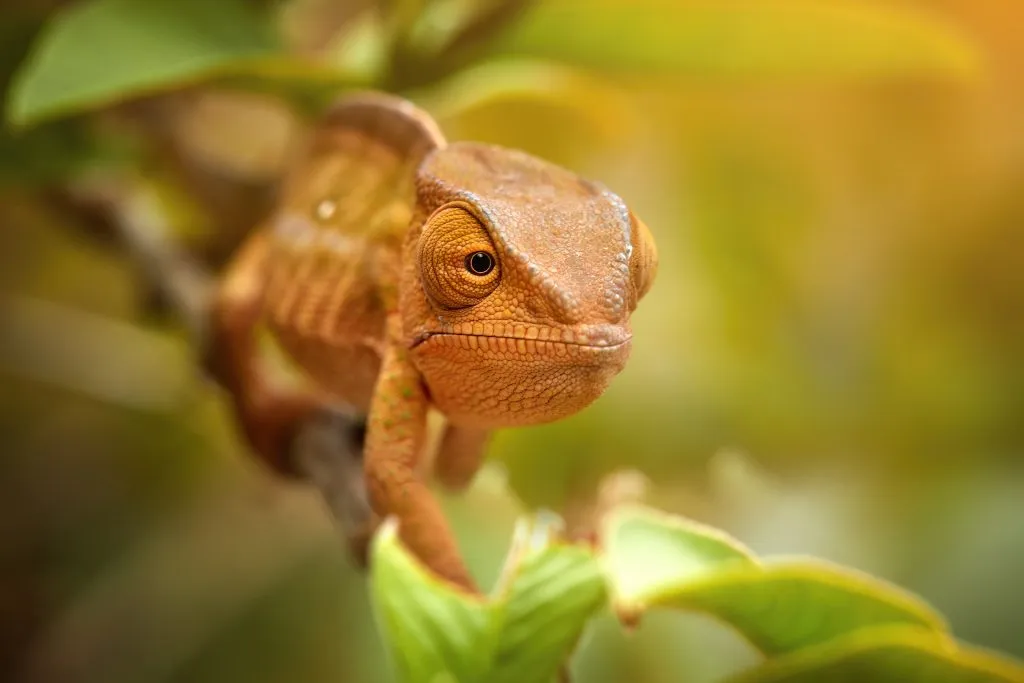
Since chameleons have interesting drinking habits, they are prone to dehydration in captivity. Below, we’ve listed some signs of dehydration in chameleons:
- Less bright skin color than usually
- Sunken eyes
- Weakness or lethargy
- Decreased appetite.
Another way to check if your chameleon is dehydrated is to gently fold its skin, and see how long it takes to move back into position.
If the skin goes back to its normal position straight away then the chameleon probably isn’t dehydrated. If it takes some time before the skin goes back, then the chameleon is dehydrated.
If your chameleon is dehydrated, you can try the following if you can’t take them to a veterinarian straight away:
- Checking the humidity and temperature in the
tank . - Misting its
tank . - Giving the chameleon water from its dripper or a syringe.
- Feeding them a fruit rich in water (such as watermelon). Don’t forget to remove the seeds.
Please note the above tips are not to be used in the place of veterinary advice. They are just things you can try whilst you’re waiting to see a reptile veterinarian.
Dehydration in chameleons can be life-threatening, so it’s important to take a dehydrated chameleon to a reptile veterinarian as soon as possible.
Metabolic Bone Disease
Chameleons can suffer from metabolic bone disease if they don’t get enough calcium or vitamin D3 in its diet. It’s usually also related to a lack of UVB light.
Signs of metabolic bone disease in chameleons are as follows (source):
- Decreased growth (in younger individuals)
- Lethargy
- Appetite loss (anorexia)
- Swollen or thick bones
- Soft jaw (mandible)
- Shaking muscles.
If you think that your chameleon might be suffering from metabolic bone disease, be sure to correct any dietary or UVB insufficiencies and take them to a reptile veterinarian as soon as possible.
We’ve put some tips to help prevent metabolic bone disease in chameleons below:
- Gut load all insects with calcium before feeding them to your chameleon
- Dust all insects with vitamin A before feeding them to your chameleon
- Make sure your chameleon has access to appropriate UVB lighting.
Mouth Rot
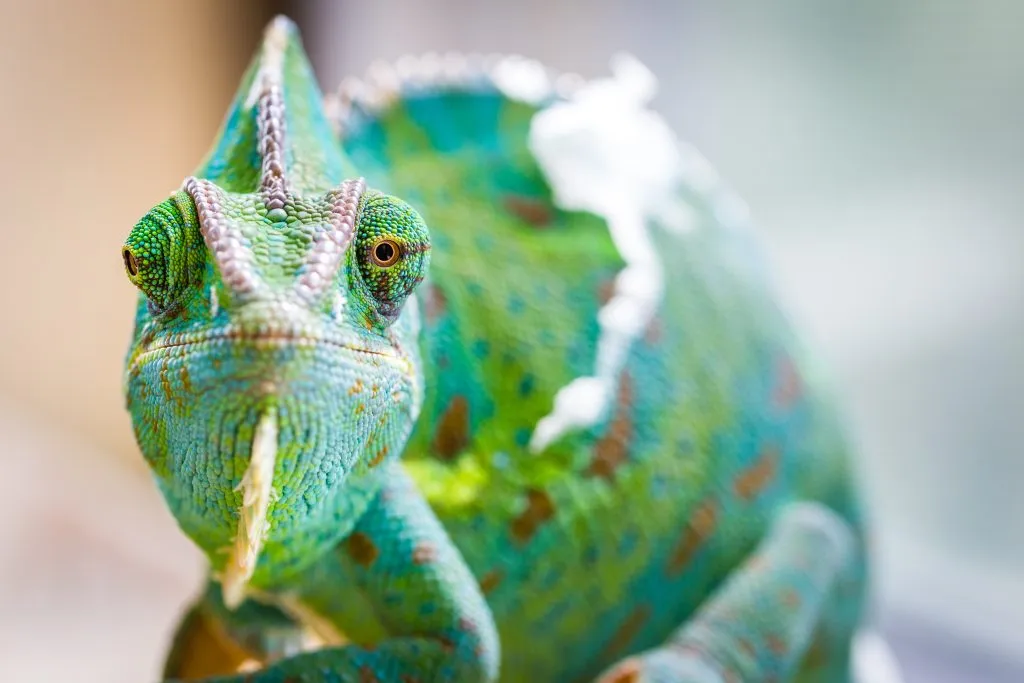
Chameleon mouth disease is also known as ‘mouth rot’ and can be caused by bacteria or viruses. It’s not that common in chameleons and is usually also linked to poor husbandry conditions.
It usually starts off with some kind of injury in a chameleon’s mouth, which then gets contaminated by microorganisms. Make sure there is nothing sharp in a chameleon’s
Signs of mouth rot in chameleons include:
- Swollen or red mouth
- Material (discharge) exiting or surrounding the mouth or on the teeth
- Bad smell from the mouth
- Changes (lumps or marks) within the mouth.
Mouth rot is a serious condition that must be treated by a veterinarian. If you think that your chameleon might have mouth rot, take them to a reptile veterinarian as soon as possible.
Parasites
Chameleons can suffer from parasites such as worms, mites, and ticks (source). You might even be able to see parasites on your chameleon’s skin or in its feces.
Both internal and external parasites are treatable in chameleons using medication from a veterinarian.
If you think that your pet chameleon might have parasites, contact a reptile veterinarian for an appropriate diagnosis and treatment. If you can, bring a sample of its feces with you for diagnostic purposes.
Most Chameleons Don’t Get Very Old
Depending on the species, chameleons live for different amounts of time.
We’ve given a few examples of common species and how long they live below:
- Veiled chameleon: 4-6 years (male), 2-3 years (female)
- Panther chameleon: 5 to 7 years
- Jackson’s chameleon: 5 to 10 years.
What To Do After A Chameleon Dies?
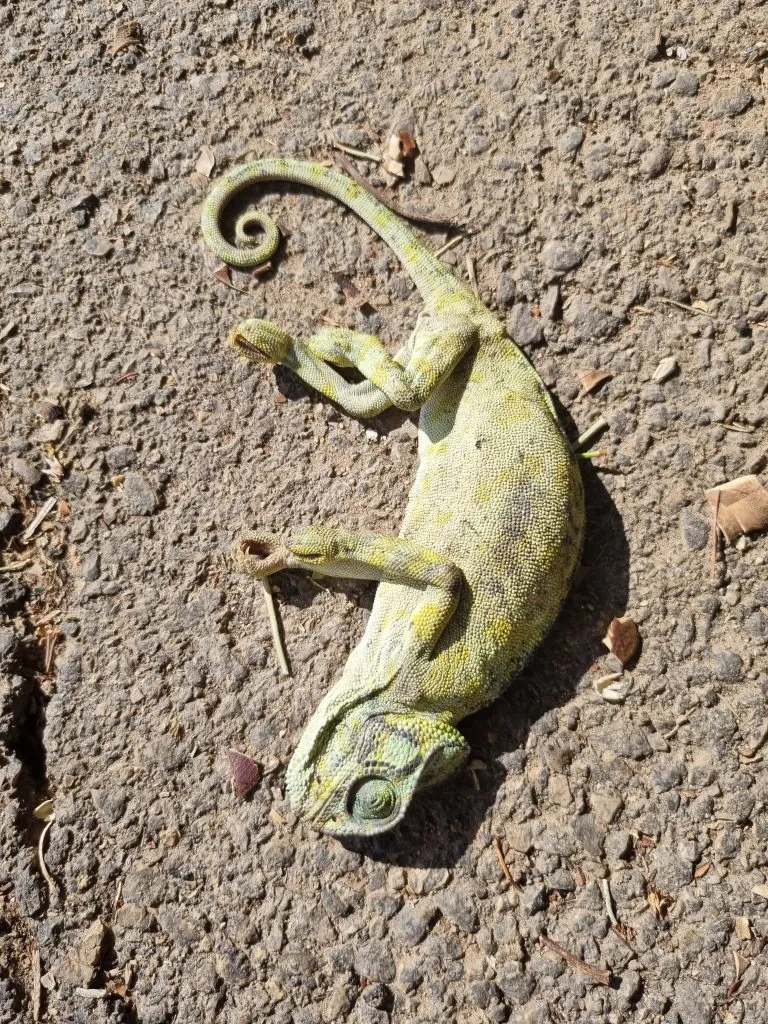
After a chameleon dies, there are a few options as to what to do next. Depending on the circumstances surrounding the death, you might consider either burying or cremating the chameleon.
If you’re not sure about the cause of death, you may also consider taking the chameleon to a veterinarian for a post-mortem examination.
Can You Bring A Dead Chameleon To The Vet To Find Out The Cause Of Death?
Some veterinarians offer a post-mortem service for animals after they die. This will help identify the reason for the chameleon dying and can provide useful information, especially if you have other chameleons.
Contact your local reptile veterinarian to find out if they offer this service and to find out more information.
What To Do With An Old Chameleon Tank If You’re Getting A New Chameleon?
If you decide to get another chameleon and house it in the same
This is to make sure that disease-causing microorganisms are not passed on to the new inhabitant of the
First, remove all components of your chameleon’s
Don’t forget, always wash your hands after being in contact with your chameleon or the components of its
Conclusion
It might not have been the most cheerful article, but it’s important to know what to look for in a dying or sick chameleon.
By familiarizing yourself with signs of illness in chameleons, you can react faster to increase the chances of your chameleon surviving.
If you’re interested in chameleon health, read our article 25 Signs Your Chameleon Is Happy And Healthy.
- Enchi Ball Python: A Unique and Stunning Morph of Python regius - March 27, 2025
- Emerald Tree Monitor: The Enigmatic Green Guardian of the Rainforest - March 26, 2025
- The Egyptian Cobra (Naja haje): A Fascinating Serpent - March 25, 2025
